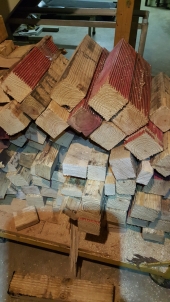


Glenn Herbert wrote:It appears that you don't have a secondary air supply. This is some added complexity, but may make a real difference in completeness of combustion. The best current practice involves a channel recessed in the firebox floor (so the air gets preheated) and a metal tube rising just in front of the port to inject the air where there is maximum turbulence. Look up "pre-port injector" for configuration and sizing.



Bruce Woodford wrote:You can build a steel core as you originally planned BUT rather than insulating it, you MUST air-cool it! Whenever steel gets over 900F it will glow red hot and corrode very quickly! RMH temps far exceed this but air-cooling on the exterior will enable you to avoid overheating your steel core. See my 7" steel air -cooled RMH at https://permies.com/t/69632/Building-tube-steel-air-cooled for more details on safely constructing a steel cored RMH that will last.

Glenn Herbert wrote:As a potter, I can attest that clay that is bone dry will wet and break down much faster than clay that is nearly dry (not changed color yet).
As long as you don't need the cob to hold together on its own, eliminating straw would be fine. If you want to make a larger structure like a bench, straw in the outer few inches at least will make it much more crack-resistant. Clay plus perlite (as much perlite as the clay will hold without being crumbly) will be a fine insulator, and a layer of clay-sand-straw cob will give a strong tough surface. For thermal mass areas where you want to absorb heat and not prevent its movement, lots of sand in the mix is best, to add mass and reduce shrinkage.

bob day wrote:I would scrape that clay off before it dries anymore and submerge it in water and reuse it with perlite mixed in like you were casting a riser--The Perlite makes it slightly less robust, but it is a better insulator. Then use the sand clay mix for the surface. I like to use a paintbrush and water to smooth the final surface, and if minor cracks appear just use a very loose clay to fill in the cracks--
btw, cob also has straw mixed in, but I generally don't bother with straw in my stoves --makes it easier to take them apart and rework the clay with water when I remodel, and as fast as the designs are evolving, that is quite frequently.

thomas rubino wrote:Not really a link but go to amazon and paste in this. ( The Rocket Mass Heater Builder's Guide: Complete Step-by-Step Construction, Maintenance and Troubleshooting )

thomas rubino wrote:It should bond better. The sand thermally stabilizes the cob, keeps it from moving as it dry's/ heats. Have you acquired the builders guide yet? It explains all this.

thomas rubino wrote:Denny, are you mixing sand into your clay ? Pure clay like a potter uses would need 3 times the amount of builders sand mixed into it. Without sand your clay is not cob. It will crack without it.
